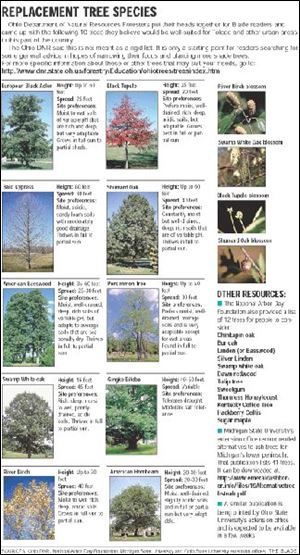
Alternatives abound for Arbor Day
4/28/2005
It's easy to get depressed about the state of trees this Arbor Day if you're in the vicinity of Pearson Metropark.
There's the buzz of chain saws, the smell of freshly cut wood, and the sight of sturdy ash trees being cut down.
All across Lucas County - and as far west as Indiana, as far north as Michigan's Mackinac Bridge, and as far south as Hancock County - some of this region's spectacular giants are being humbled by man's fear of a tiny beetle few people have ever seen, the emerald ash borer.
For that reason, area tree experts view this year's Arbor Day - which is celebrated tomorrow - with special meaning.
Founded in 1885 by J. Sterling Morton, a former Detroit-area resident stunned by the lack of shade he found in Nebraska after moving there, Arbor Day is one of those events that has gone largely unnoticed for years. But this year's theme has an especially strong emphasis toward diversity for Ohio and Michigan.
"If you've got room to plant five trees, plant five different trees," said Amy Stone, an Ohio State University extension agent in Toledo who made Ohio's first emerald ash borer discovery.
She and Robert Gentry, Adrian parks and forestry superintendent, worry that society didn't learn from the demise of the American elm, once the nation's most popular shade tree.
Elms were stricken by the fatal Dutch elm disease in Cleveland in 1930. By the 1960s, the species had nearly vanished.
Ash was viewed as an ideal replacement. Like elms, they're big, shady trees. They adapt to many soil types. Their attractiveness made them the darling of landscapers.
Now widely seen as this generation's biggest tree threat, the emerald ash borer was discovered in 2002. Ironically, it was found in the Detroit area, where Mr. Morton's love for trees grew. A year later, Ms. Stone found it in Ohio for the first time, near Whitehouse.
Ohio Department of Natural Resources foresters recently put their heads together to come up with a list of 10 urban-friendly trees to consider planting.
Trees on their short list generally do well in the Toledo area's soil. But many factors must be considered before planting, such as drainage patterns, sunlight, and proximity to other trees and power lines. "We're not saying that's a list of trees that will do well in every situation," Andy Ware, Ohio DNR assistant forestry chief, said.
For detailed information, go to http://www.dnr.state.oh.us/forestry/Education/ohiotrees/treesindex.htm
The National Arbor Day Foundation put out a similar list. Last summer, officials at the Michigan State University extension office put out a list targeted for residents of Michigan's lower peninsula. Ohio State University's extension office is compiling a list of its own.
Because of the variables, there is no widespread agreement on what should be planted. "People spend a lot of time doing research when it comes to buying a car or a washing machine. You have to do the same thing if you buy a new tree," said Dan Herms, an OSU entomologist at the Ohio Agricultural Research and Development Center in Wooster.
The diversity theme rings strong this year, even though Ohio has been the nation's leader in the number of Tree City USA communities for more than two decades. A total of 236 communities, including Toledo, have achieved that designation for maintaining a healthy assortment of urban trees.
Drew Todd, Ohio DNR urban forestry coordinator, said he's pleased by the renewed focus on diversity. "The silver lining behind the emerald ash borer is an awareness factor for communities to take stock of their resource," he said.
Research has been intensifying in terms of trying to find a chemical treatment and trying to develop a hybrid species. The latter seems to hold more promise, Mr. Herms said.
Government officials haven't found a panacea in terms of an insecticide. Current products are costly, must be applied yearly, and could have a potential impact on the environment if applied in the volumes that would be necessary. The biggest drawback: They work only for strengthening the defenses of trees that haven't been attacked. Once the emerald ash borer has found its way through the tree bark, there is no known insecticide to kill off it or its larvae, said Mr. Herms, who represents Ohio on a multi-state research panel.
The possibility of cross-breeding Asian and North American ash species into a beetle-resistant hybrid is promising. The largest tree farm for this research is near Novi, Mich., where some 800 trees have been planted. Two smaller farms were established recently in the Toledo area. One with 200 seedlings is on Manhattan Boulevard between Suder Avenue and Summit Street. Another, with 150 seedlings, is on Goetz Road near Sylvania-Petersburg Road in Monroe County's Summerfield Township, Ms. Stone said.
Meanwhile, officials remain firmly behind the multi-state effort to kill off the beetle by trying to separate it from its food source. It feeds exclusively on ash. All trees within a half-mile of known infestation points are ordered to come down.
Their hopes are buoyed by the apparent success in combating another pest, the Asian longhorn beetle, in the Chicago area.
"This is a critical time. Whether or not we are going to be able to stop the emerald ash borer will be decided in the next couple of years," Mr. Ware said. "We wouldn't agree with people who feel it's a lost cause."
Contact Tom Henry at:
thenry@theblade.com
or 419-724-6079.